PPC Optimization: 7 Low-Hanging Fruit Opportunities

PPC Optimization: 7 Low-Hanging Fruit Opportunities
PPC optimization is an essential part of running online advertising campaigns. Companies must seek to get the most out of their clicks and impressions, especially if each interaction is costing them.
Did you know that PPC campaigns generate a 200% average ROI?
Pay-per-click (PPC) is an essential part of advertising strategies worldwide. Primarily hosted on search engines, PPC offers companies many benefits that actively promote goods and services.
Advertisers can run a PPC campaign on just about any size of budget — they’re able to invest in their ad content as they see fit. However, several best practices allow businesses to make the most from their ad spend.
This is where PPC optimization comes in. Companies looking to make meaningful connections with customers through ad campaigns without sacrificing a reasonable budget should consider adopting PPC best practices.
This guide will:
- Define PPC optimization
- Highlight the features that make up a PPC campaign,
- Showcase the top 7 approaches to optimizing a PPC ad
Looking for help optimizing your PPC campaign? The Manifest has you covered — check out our top-rated PPC agencies that can help construct campaigns that convert.
What is PPC Optimization?
PPC optimization refers to using best practices to make PPC ads more effective. People can maximize the value of PPC ads by focusing on their target keywords, adjusting bidding strategies, running a competitive analysis, and enhancing both ad copy and landing pages.
5 Key Features of Optimized PPC Ads
PPC optimization can seem like a daunting process due to all possible customizations involved within ads.
While determining ad and landing page copy might demand some extra creativity, PPC ads are generally structured in the same ways.
For instance, here are the five main components of a PPC ad on a SERP such as Google:
- Headline
- Description lines
- Display URL
- Landing page and destination URL
- Snippet, price, and sitelink extensions
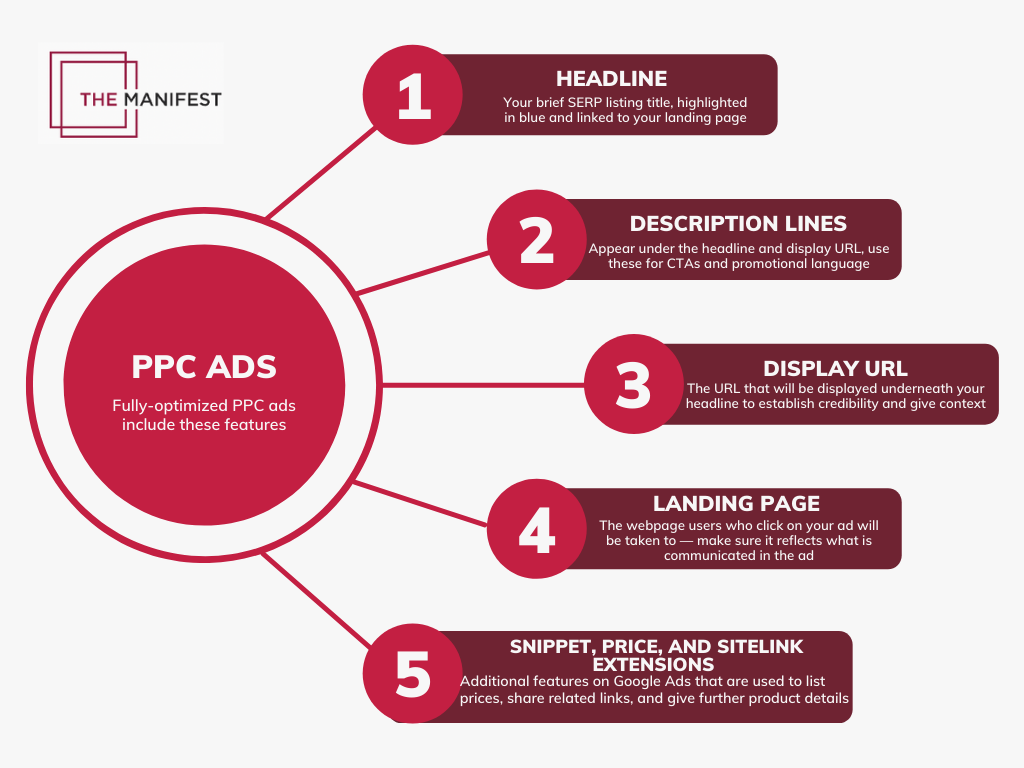
1. PPC Headlines
A PPC headline is what a user will see first on a SERP. Your headline is the text that is liked to your website, and people will click on it to access your landing page.
Below are two Google Ads that appear for the keyword “coffee makers.”
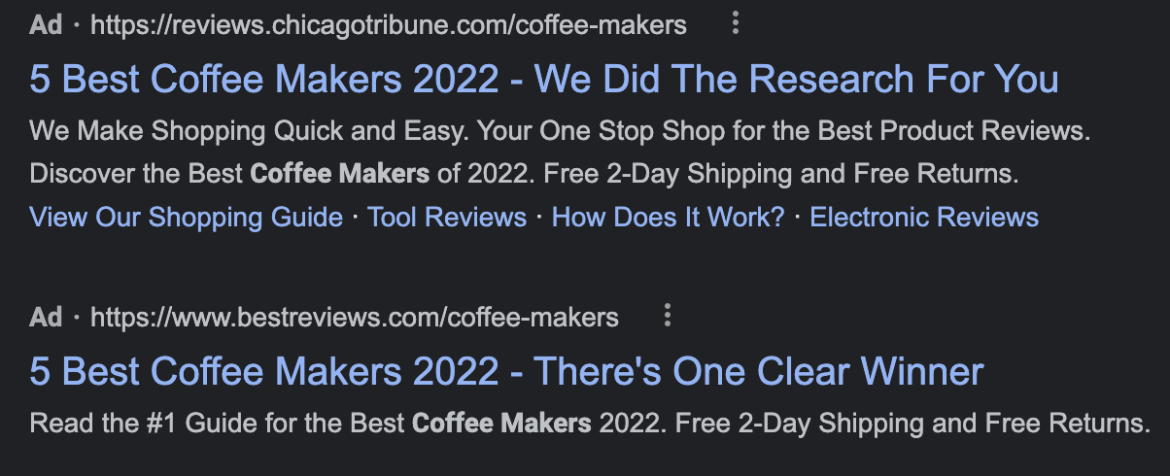
You’ll notice that both of the headlines are promotional and contain the target keyword:
- 5 Best Coffee Makers 2022 - We Did The Research For You
- 5 Best Coffee Makers 2022 - There’s One Clear Winner
The first headline for both ads appears the same, prominently highlighting the keywords and the current year. The second headline for each ad is more creative and promotional, encouraging clicks from viewers interested in coffee makers.
Note: Google now allows advertisers to use up to 90 characters within an expanded text headline but notes that expanded text ads will only be available to be created until June 30, 2022. It’s recommended that companies transition to responsive search ads instead.
2. Description Lines
Description lines appear under the hyperlinked headline and provide some more context on the advertised product or service.
For instance, if a user searches for “realtors” on Google, several ads, including this one, will pop up.

Below the headline reads this description: “Doing You Own Research on Top Real Estate Agents is Tough. We’ve Done the Work for You.”
The description acknowledges that the reader is looking for realtors and that finding an excellent real estate agent isn’t as easy as it seems.
It also claims that the advertising company has already collected research for the public on relators, indicating that the user doesn’t need to look further for answers.
Description lines elaborate on the headline and provide additional context to what companies offer through their ads. There is only one description line in this example, but you can add more if advertisers deem it necessary.
3. Display URL
The display URL is the URL that appears at the top of an ad, above the headline and directly to the right of the “Ad” marker.
The display URL gives the viewer an idea of where they will be taken if they click on the ad. It helps prospective customers quickly verify the company's legitimacy before investing extra time after clicking.
While the display URL acts as a window to the landing page, it isn’t necessarily the URL the user will be taken to upon clicking the ad.
Companies can easily adjust their display URL in the Google Ads Editor.
4. Landing Page
A landing page is a webpage that a user will be redirected to after clicking on your PPC ad. The page is on the advertiser’s domain and should directly relate to the topic of the advertisement.
For instance, if a user clicks on the real estate agent ad mentioned earlier, they will be brought to the page below.
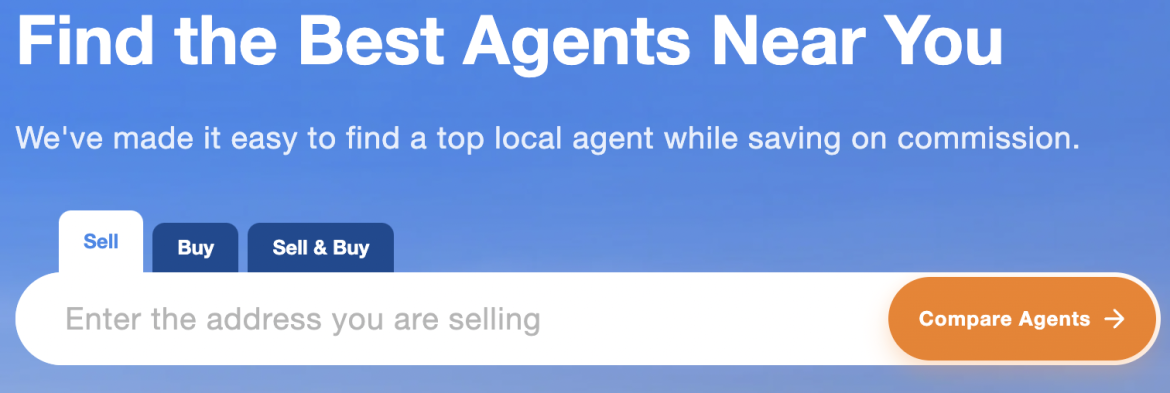
Source: UpNest
The ad copy informed users that real estate agent research was already done for them and could easily be accessed if they clicked the ad.
This appears to be accurate, as the landing page for the ad takes people to a tool meant to compare real estate agents depending on whether they’re buying, selling, or both.
Here, the advertising company made sure there was a direct relationship between the ad copy and the functionality of the chosen landing page.
5. Snippet, Price, and Sitelink Extensions
In addition to the above examples of typical SERP PPC features, companies also have the option to add extensions to their ads. These include snippet extensions, price extensions, image extensions and sitelink extensions.
- Snippet extensions: showcase a particular feature of your product (i.e. Style, available colors)
- Price extensions: highlight the price of a product directly on the PPC ad
- Image extensions: allow people to include visuals within their ads, often boosting CTR
- Sitelink extensions: feature similar pages that relate to your destination and display URLs nested underneath the main ad content
Each of these extensions serves advertisers in drawing more attention to ad content and attracting links from interested viewers.
However, the sitelink extension also offers the added benefit that help your ads take up more space on a search results page, allowing you to stand out from competitors and advertise for your keywords.
For instance, travel company Expedia uses sitelink extensions that expand it to owning 5 first-page URL listings for the keyword “travel agency.”
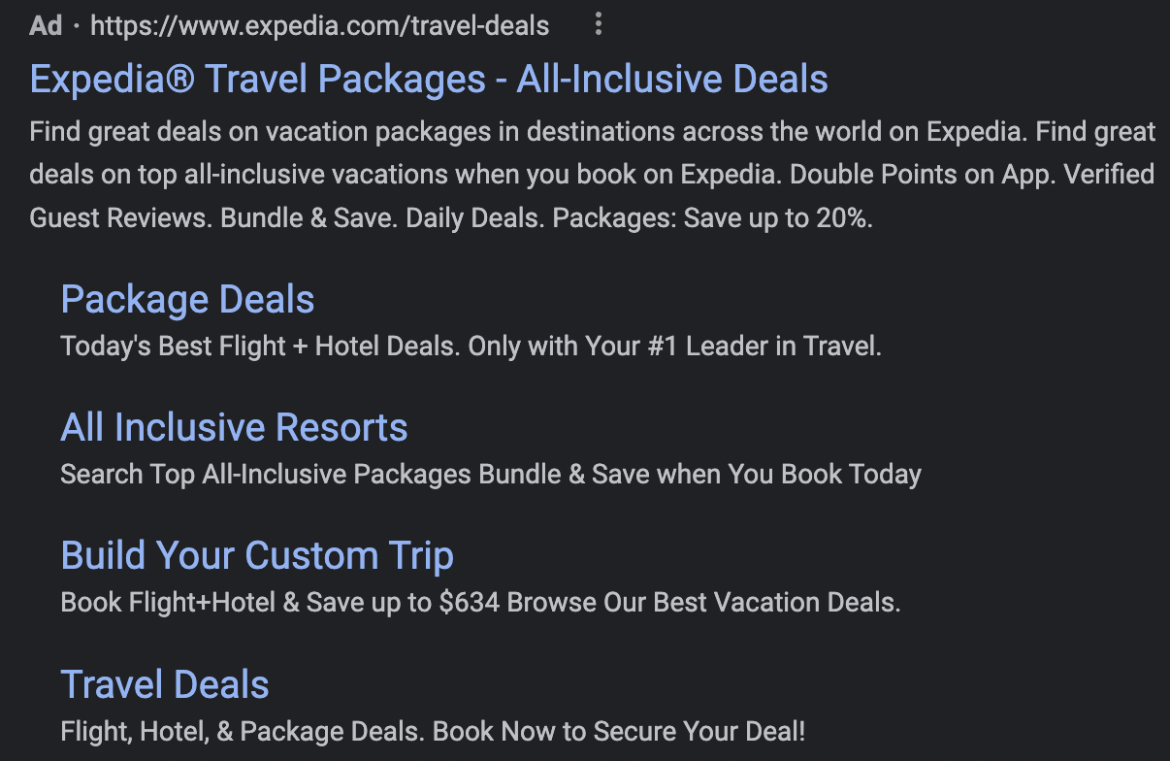
When Google users search this keyword, a typical PPC ad promoting travel packages appears along with four other headlines, lines, and descriptions on “package deals,” “all-inclusive resorts,” “build you custom trip,” and “travel deals.”
These nest sitelink extensions naturally fall under the topic presented in the main ad but offer additional and more specific resources to customers who know what they want.
Sitelink extensions are available at the campaign and account level through Google Ads. Advertisers can also opt to choose between dynamic and manual extensions.
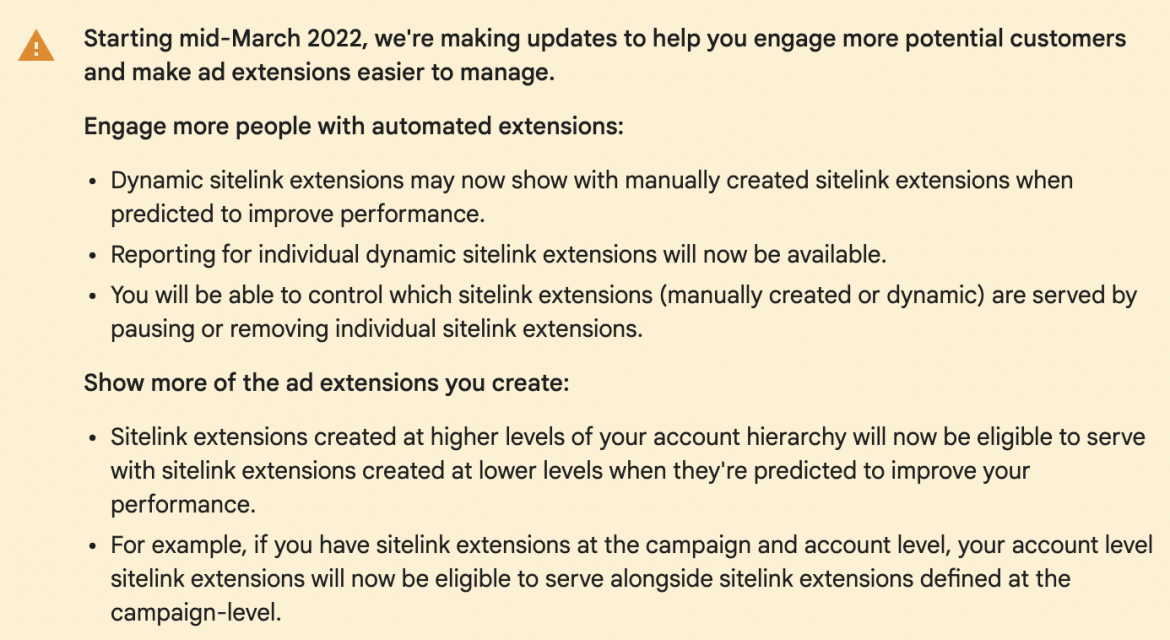
Source: Google Ads Support
For those using Google Ads to develop PPC campaigns, Google continues to refine and expand their sitelink offers to make them more appealing to users and easier to manage on companies.
7 Opportunities for PPC Optimization
A successful PPC campaign requires agencies to use each feature of a PPC ad effectively within the context of a larger advertising strategy. To get started, we recommend that PPC professionals follow these 7 steps for PPC optimization:
- Target relevant keywords
- Run a competitive analysis
- Select reasonable KPIs
- Reevaluate how you bid
- Refine and experiment with ad copy
- Consider targeting advertising
- Build a conversion-focused landing page
1. Target Relevant Keywords
The first step of any PPC campaign is keyword research. However, your strategic approach can become outdated if your advertising team isn’t checking on which keywords maintain relevance to your business over time.
If you’ve been running PPC ads for a long time, look at your target keywords for upcoming campaigns. Are these terms directly related to what users are searching for? Do they reflect your services or goals?
This exercise is vital for companies experiencing growth or change. If your keywords are outdated, revamp them by highlighting the most relevant terms to your products and services.
For instance, 1-800-FLOWERS is a flower delivery service that specializes in fast delivery. Any company selling flowers will want to rank for the highly-searched keyword “flowers.”
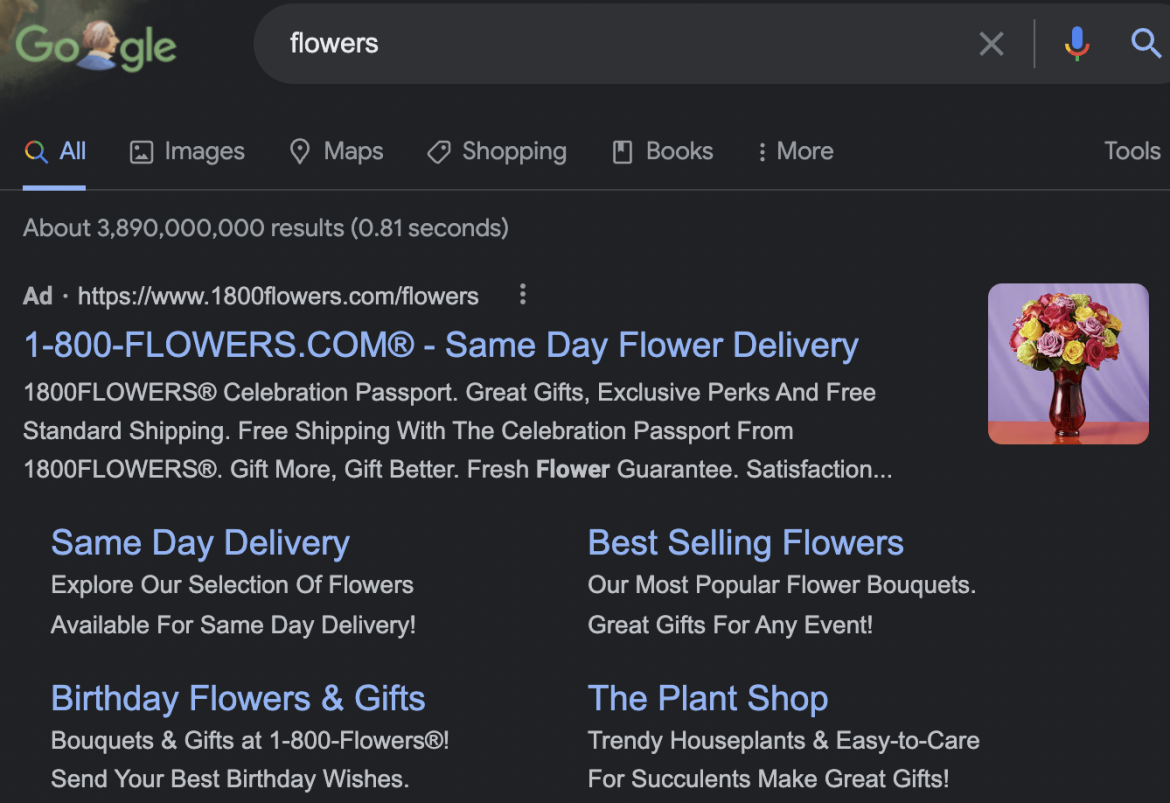
The company takes this keyword seriously because of its high search volume and direct relation to its services. 1-800-FLOWERS is the top-ranking ad for the search, including four sitelink extensions and a PPC ad image.
By maintaining the top ad placement for these keywords, the company is both funneling traffic to its product pages and brand-building by encouraging customers to think of the company when they’re looking for ‘flowers.’
Companies looking to replicate this success should brainstorm a list of topics, words, and phrases related to your services. Then, examine whether these keywords have a significant search volume using a tool like Ahrefs.
Make Sure to Add Negative Keywords
You’ll also want to designate a list of negative keywords during this process. Negative keywords are terms or phrases you don’t want to be found for via search, even if they relate to your industry.
Pro tip: Phrase match negative keywords are more commonly used and are most helpful in developing a strong negative keyword list. As ads run, you will want to continuously update your negative keyword list to include additional phrases coming through that aren’t a user intent match.
For instance, 1-800-FLOWERS focuses on flowers as gifts, so they may not want to be found on Google for keywords associated with flower gardens or gardening supplies. Even though both types of keywords have to do with flowers, one group wouldn’t be helpful to the company or users looking for flower garden tools.
This is where a negative keyword list would help to keep 1-800-FLOWERS ads centered on their main service lines.
Target and negative keywords are essential parts of the PPC optimization process and should be regularly checked and adjusted as businesses scale.
2. Run a Competitor Analysis
Competitor analysis helps companies compare their PPC ad performance to their direct competitors.
Through running a competitor analysis, businesses can discover keywords gaps between their ads and others in their industry. Additionally, it helps keep your finger on the pulse of the industry and gives you more of a chance to outrank others for important terms.
Advertisers can run a competitor analysis using various tools, including Semrush.

Source: Semrush
Insights from PPC tools and technologies allow businesses to refine their strategies based on other companies in the industry.
PPC experts find that a competitive analysis is a critical part of the PPC optimization and budgeting process. Steven Light, the co-owner and CMO of the e-commerce company Nolah Mattress, recommends keeping tabs on competitors for PPC advertisers on a budget.
“Rather than using trial and error to crawl towards the strongest keywords and bids, a little competitor analysis can help point you directly towards them, making budget creation a far simpler process,” Light said.
Light finds that a thorough competitive landscape analysis helps companies understand:
- Competitor bidding practices
- Competitor investment
- Competitor keyword targets
- Other PPC behavior
In gaining insights into how your direct competitors are executing their PPC strategy, you’ll have an opportunity to react and adjust where needed to compete more actively against them without going over budget.
3. Select Reasonable KPIs
There are tons of metrics out there — in PPC and otherwise. How do you know that you’re choosing the ones with the most impact?
The first rule of thumb is to make sure you’re not choosing to track too many KPIs. This may bog you and your team down with vanity metrics that confuse your goals. Stick to what is most important to you.
To get you started in KPI selection, here are just a few of the top KPIs for PPC campaigns used by companies around the world:
- Average position: where your ads are ranking on average across your campaign. The ad ranking first will receive the most clicks, so companies may deem this important to track.
- Clicks: The number of clicks an ad received over a given period (aka how many times are people being directed to your site via an ad)
- Click-through-rate (CTR): the number of clicks your ad gets divided by the number of times it was shown — provides a percentage of how many people who see your ad decide to click
- Conversion rate: the percentage of people who click on your ad that become customers (or take another designated action), revealing if the ad is generating revenue
- Cost-per-click (CPC): the amount of money a company spends each time a specific ad is clicked — more competitive keywords have a higher cost-per-click
Companies generally need to track more than one KPI to have a complete picture of the status of their PPC campaign but shouldn’t exceed more than 3–4 without good reason. This will keep your team focused on what matters most to your company.
4. Reevaluate How You Bid
Bidding is the process of either manually or automatically setting prices you’re willing to pay for a top ad slot in a PPC auction. Google Ads, in particular, is known in the PPC community for its auction-style bidding process.
Depending on how liberally you choose to bid, you may be missing out on top advertising slots or not bidding enough to obtain an ad placement worth your investment. Part of PPC optimization is revamping your bidding style to align with your goals and budget.
Manual vs. Automated Bidding
One of the key choices advertisers make when setting up a campaign is whether to use manual or automated bidding.
Manual bidding is done without the help of AI solutions to recommend bid amounts. Instead, bids are wholly managed by an advertiser or PPC professional themselves. Manual bidding is a more cost-effective approach to PPC but also requires that someone on your team has the experience and confidence to place bids on your company’s behalf.
On the other hand, automated bidding relies on smart solutions and machine learning to determine what bid is most appropriate and effective on a case-by-case basis. This way, the hard work is off your team’s plate. However, this comes with limitations on what your team can control within the bidding process.
Automated PPC Bidding Approaches
Just like there’s more than one way to execute a bid, there are also several ways of structuring the framework of a PPC bidding process.
While automated bidding has limits, advertisers have power over several aspects of bidding. Those looking to optimize PPC campaigns should pay close attention to these automated PPC strategies:
- Target CPA: automated bidding solutions will aim to earn as many conversions that fall within your cost-per-acquisition target as possible — can serve as a strong option for budget-conscious companies.
- Target ROAS: automated system targets maximizing your return on ad spend, but companies must allow Google to track conversions through PPC ads to do this.
- Maximize Conversions: the automatic bidding software will bid to earn the most possible conversions for your company. This sounds great, but remember that it will overlook the cost of expensive keywords, so you could quickly go over budget.
Examine these approaches against your current bidding strategy to see if there’s anything that could be changed for quick returns.
5. Refine and Experiment with Ad Copy
Ad copy is one of the most important aspects of a PPC ad.
Copywriting can be a very creative process, depending on your industry. That’s why it’s wise to test out a few different versions of PPC copy to determine what resonates with customers.
For instance, here’s another ad from 1-800-FLOWERS. Much of the ad copy is the same between the two ads, highlighting their free shipping and how their products are great gifts.

The company has struck the right chord, given the consistency in ad copy between the two ads. But what if you’re not feeling as great about your copy?
Experts recommend testing ad copy through A/B testing, which examines ad quality by releasing two versions of the same ad to compare their results.
A/B testing makes analysis straightforward. If you keep everything except the ad copy the same, it’s clear what phrases better appealed to your audience.
If you’re feeling any uncertainty about the quality of your ad copy and whether it could be more effective, try using A/B testing to see if there’s room for improvement.
6. Consider Targeting Advertising
Targeted advertising is an online advertising approach that involves selecting certain traits about your audience to target with certain content. This process lends itself well to PPC optimization.
While some companies have adjusted their policies for how companies can target to preserve privacy, targeted advertising is still a part of major PPC vendor offerings.
Generally speaking, Google and other companies are already familiar with the demographic traits of most of its users. That means that companies can serve targeted ads based on the following traits and others:
- Race
- Age group
- Educational background
- Generation (Millennials, Baby Boomers, etc.)
- Income
- Religion
Targeted advertising can improve PPC campaigns by bringing companies closer to their target audience. If a company is otherwise struggling to connect with a certain group, they can deliberately get in front of them through targeted advertising.
Leverage Remarketing
According to Google, “Remarketing lists for search ads (RLSA) with Analytics works much the same way as standard RLSA.
You use Analytics to help define the criteria for adding customers to remarketing lists; Google associates sessions on your site (based on your Analytics criteria) with one of Google’s advertising cookies on users’ browsers. When your customers later search on Google (from the same browser), they may see customized ads based on their previous sessions on your site.”
Relevant reading: ‘What Benefits Can Search Retargeting Offer Small Businesses?’
7. Build a Conversion-Focused Landing Page
As mentioned earlier, all PPC ads must link to a landing page. Companies have direct control over which page users encounter after clicking an ad, so it’s important to make the most of that!
There are plenty of tools to help advertising teams quickly and easily make landing pages, but there’s still a lot to consider before diving in.
Your landing page should relate to your ad copy and content. Consumers will feel confused and misled if they don’t see what they expect on your landing page. If you want conversions, you’re going to have to maintain trust.
Companies aiming for PPC optimization should ensure their landing pages are built for conversions. In addition to trustworthiness, the page should make it easy for consumers to make a purchase or take a desired action.
For instance, if users click the 1-800-FLOWERS ads mentioned earlier, they’re taken to a page that showcases the flower gifts they can send.

By separating products by categories displayed within the ads, the company shows consumers content they expected to see. The prominent product images and categories are eye-catching and feature what the company can offer.
With a simple click, users can begin putting together the flowers they wish to send, just as they intended to upon clicking the ad.
This straightforward process makes the ad and landing page compatible and conversion-focused.
PPC Optimization is Critical for Sustained Success
PPC optimization is all about improving and reworking your advertising strategy over time. Companies grow, and PPC best practices evolve. To stay ahead of your competition, it’s crucial to revisit low-hanging fruit opportunities within your PPC strategy and optimize them.
Experienced PPC Companies Deliver Long Term ROI
This isn’t the sort of activity you will want to try on your own if you don’t have any clue where to start. An experienced PPC team knows exactly which levers to pull and will stay up to date with all of the changes Google and other ad platforms impose on the market—saving your business time and money in the long run. The entire responsibility of a PPC Agency is making sure your campaigns perform and with minimal waste in ad spend.
Need help optimizing? Hire a PPC agency that’s been vetted and rated on The Manifest.
Additional Reading:
